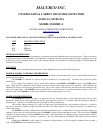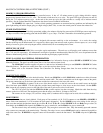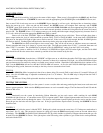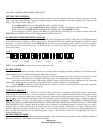
3
MACURCO CONTROLLERS & DETECTORS (CONT.)
SS103 OPERATION
START-UP
Turn the FAN sensitivity level pots to the center of their ranges. When power is first applied to the SS103, only the Green
“POWER” light should be on. If SS102HC-1 sensors are used, the appropriate green SENSOR lights on the SS103 will be on, and
One or more FAN circuits may turn on as the SS102HC-1 goes through its self test cycle, which provides an increasing voltage
during the warm up cycle. After one and one half minutes, the SS102H sensors will complete their warm-ups, and all SS102
“SENSOR” green lights should be on. (If not all zones are used on the SS103-3A &-10A only those appropriate green lights will be
on). These SS103 green lights show the sensors are on and in normal operation, and that the wiring between the sensor and control
panel is OK. The SS102HC-1 has a 2 1/2 minute warm-up cycle, during which the output voltage progressively increases from 1.0
to 2.1 volts, which will cause the appropriate SS103 zone lights to actuate.
Some or all of the Red “SENSOR” lights on the SS103-10A panel may be on at this time. These red lights show when a
sensor output reaches the level of carbon monoxide to actuate FAN1, FAN2 or FAN3/ALARM. At the same time a SENSOR Red
light turns on, the amber FAN light or lights start to flash on and off. If the level of CO is high enough, the Red ALARM light also
will flash on and off. Flashing lights indicate that the time delays before relay turn on has been activated.
The SS103-3A has multi-colored lights to show sensor status. They will be off on zones to which no sensors are connected.
Normal operation and clean air is shown by a green sensor light. The light turns amber when “FAN 1” is actuated, then turns red
when “FAN 2” is exceeded. The ALARM relay is delayed, by the ALARM DELAY setting, from the FAN 2 level setting.
Allow the system to stabilize for 10 or 20 minutes. All SENSOR red lights, the FAN amber lights, and the red ALARM
lights should be off once the sensors have warmed up, and the air has been cleared out by the fans.
SS103-10A
For the SS103-10A, from the time a “SENSOR” red light turns on, at which time the amber FAN light starts to flash on and
off, there is a two minute delay before the fan relay is actuated, as shown by a continuous FAN light. Any of the SENSOR red lights
turn on whenever the Fan sensitivity setting is exceeded at any sensors location. Should the Carbon Monoxide level continue to rise,
FAN 2 on the SS103-10A will turn on, then the FAN3/ALARM will turn on. At first, the red FAN3/ALARM light flashes on and
off during the delay period, then turns on steady as the relay closes to actuate the alarm circuit.
SS103-3A
The SS103-3A differs in operation in that it has a shorter delay (30 seconds) FAN on and a short (15 second) FAN turn off
delay. Also, the ALARM range is adjustable continuously from 3 to 33 minutes. This ALARM relay is delayed from the FAN 2
turn on set point.
The unit uses 10Amp field replaceable Autofuses on the three output relay circuits to protect them.
TESTING THE SYSTEM
The best way to functionally test the systems is to run a car (the older and smog producing the better) near each sensor and
observe system operation. Make sure the SS103 potentiometers are set in reasonable ranges: The Fans between 50 and 150 and the
Alarm at 200 or less.
SS102H
Functionally test the system by introducing Carbon Monoxide gas into each sensor, while watching for each SS103
SENSOR red light to turn on. A convenient source of CO is cigarette smoke. Hold a lighted cigarette under each sensor, for several
minutes, so the smoke drifts up through the sensor. Gas from an unlit butane cigarette lighter can also be used to test the system.
Shoot the gas into the holes near the lights of the case. If the job specifications require actual CO testing, the SS102HC-1 sensors
should be used.
SS102HC-1
A switch inside the sensor is labeled TEST. Pushing this switch once puts the sensor into a 2 1/2 minute test mode where it
steps from 1.0 to 2.1 volts. This progressive increase in voltage will cause the SS103 control panel to turn on Fan and Alarm relays
accordingly. The SS102HC-1 optional Field Calibration Kit (FCK), which includes a cylinder of 50 ppm carbon monoxide gas, can
be used to test the SS102HC-1 sensors. If the job requires actual CO testing, other cylinders of gas at other levels can be purchased,
and used with the FCK.







